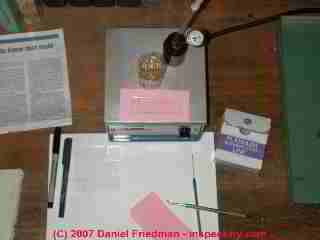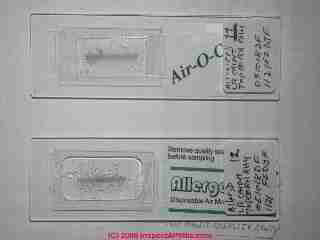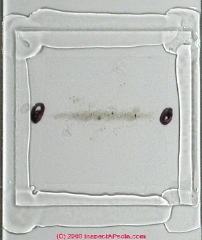 Microscope slide preparation methods
Microscope slide preparation methods
How to prepare slides of
dust, mold, pollen, bioaerosols - for indoor air quality analysis - Mold Testing Laboratory SOP
- POST a QUESTION or COMMENT about microscopy lab procedures & SOPs
Aerobiolgy & forensic microscopy lab procedures:
How to prepare microscope slides for lab analysis. This is a collection of aerobiology and mold testing lab standard operating procedures - SOP's and slide preparation recipes useful for identification of mold, pollen, animal dander, skin cells, mite fecals, mouse dander, and other airborne allergens and bioaerosols. Comments and suggestions are invited.
InspectAPedia tolerates no conflicts of interest. We have no relationship with advertisers, products, or services discussed at this website.
Slide Preparation Procedures & Guidelines

Our photo (left) shows particle traces from two different air sampling cassettes prepared on microscope slides for further evaluation.
Our study comparing the performance of these cassettes is found at AIRBORNE PARTICLE TEST SAMPLING CASSETTE STUDY.
Article Series Contents:
- MICROSCOPE SLIDE PREPARATION
- MICROSCOPE SLIDE BULK SAMPLE PREP - tips for preparing successful microscope slides from bulk material samples such as wood chips & scrapings collected during environmental sampling
- MICROSCOPE SLIDE PREP - PERMANENT MOUNTS: Cargille meltmount™ - slides for rapid field or laboratory use, how to prepare - microscopy lab procedures
- MICROSCOPE TECHNIQUES: Microscopy - Microscope sources, different types of microscopes, microscope techniques and laboratory procedures for indoor air quality, toxic mold identification, & bioaerosol investigations - microscopy lab procedures
Microscope Slide Stain and Media Recipes
How to Prepare Permanent Microscope Slide Mounts
 Here is a list of some candidates. WARNING: some of these involve dangerous chemicals, possibly carcinogenic (cancer-causing) and should
be used only with expert advice..
Here is a list of some candidates. WARNING: some of these involve dangerous chemicals, possibly carcinogenic (cancer-causing) and should
be used only with expert advice..
- Canada Balsam - traditional, excellent slide mounting media, generally not available. See Cargille's "Meltmount" alternative.
- Clear nail polish - experimental -DF
- Damar Varnish - see Brinkworth and Smith article below
- Fructose Larry Legg's recipe
- Glycerin or glycerine jelly. DF note: we've been disappointed that even after adding phenol or other preservatives some of our glycerine jelly slides become cloudy or even opaque with age. We no longer recommend this mountant for permanent slide mounts.
- Gum Arabic (Acacia) or similar water soluble gums
- Hyrax / Dirax high refractive index mountants - Northern Biological Supplies
- Lactic acid combined with phenol (carbolic acid), polyvinyl alcohol, glycerine, water. (Not for caliciferous materials - you'll find that materials like drywall dust, gypsum, some plaster contents, will dissolve and then recrystalize in this media)
- Loctite glass bond - local auto supply stores, needs UV light to cure - experimental, Brinkworth and Smith [DF note: We have had good results using this slide preparation media for permanent mounts of certain particles; we need to research the refractive index but in general that's not been a problem with paint samples nor with fungal spores or other common indoor building dust particles. We use a halogen lamp to generate the UV needed to cure the mountant.
- Meltmount - see CARGILLE MELTMOUNT PROCEDURE
- Mowiol - available from Burkard as a replacement for Gelvatol - burkard.com
- NBS Bioseal Two
- Numount - from Brunel microscopes & Northern Biological Supplies
- The Stains File - stainsfile.info/StainsFile/jindex.html This is the most extensive list we have found of slide preparation stains.
However it's quite shy on stains for pollen and spores. Above are listed stains and recipes of particular interest to aerobiologists and for which I have detail or alternatives beyond the information at the Stains File. - Turtox - no longer available, formula sought. See Howey's article
- Water soluble gums - gum Arabic (Acacia)
How to Use Gelvatol to Prepare Microscope Slides - A Detailed Step by Step Procedure
Recipe for Gelvatol Slide Mount Medium
Gelvatol may be used as a permanent slide mounting medium for mold spore or pollen slides. Gelvatol has been replaced by Mowiol from Burkard - see Mowiol below.
- 100 ml H2O (I would use distilled water)
- 35g Gelvatol (or Mowiol from Burkard)
- Polyvinyl alcohol (from Fisher Scientific, or other sources)
Heat to dissolve, not to much. Then add:
- 50 ml Glycerine (Glycerol, Fisher Cat. No. ?)
- 2g Phenol (as a preservative if needed)(Phenol smells a lot and it is no good for health, it gets yellow with time, I do not use it)
Add
- ACID fuchsin (as a colorant for SPORES if needed - Fisher Cat. No. AC22790-0250) Just use a few crystals, mix and wait. Add more if wanted, do not use too much as it will hide the structures.
OR BASIC fuchsin (as a colorant for POLLEN if needed - Fisher Cat. No. NC9653986)
OR no colorant
Keep closed tight because it gets harder as it gets in contact with air.
Source: Burkard company; I was told that they call the "polyvinyl alcohol" Gelvatol, a product available from Burkard.
Reader Question: getting rid of air bubbles trapped in the Gelvatol?
(Apr 4, 2014) Anonymous said:
I've got a lot of tiny air bubbles trapped in the gelvatol I prepared. I left it for a while and remove them, but more bubbles form when touch with a glass rod. How can I get rid of them?
Reply:
Anon. I would try heating the gelvatol - not hot enough to make it bubble or you'll have to start all over. Gently heat and watch it. When viscosity is pretty low, try tapping the container on a surface.
Also I find that one or two small bubbles in the mountant can be easily pushed to one side when I put on the cover slip. Or if there is not enough mountant under the cover slip I use a pipette to introduce a bit more mountant from one edge, later wiping that edge clean.
If more bubbles are forming when you push down on the cover slip I suspect something else is going on, possibly a chemical reaction with the substance being examined, or or you are pushing out air that was trapped in the mounted particles. For example, gypsum (drywall dust) in some indoor dust samples will froth many mountants, and flower or insect parts or large samples of fairly large or disparate particles will sometimes trap air that needs to be expelled.
Often after the cover slip is in place I will press down on it gently with the non-pinching end of a small pair of tweezers over which I've mounted a rubber dropper bulb. The bulb on tweezers gives me a dual -purpose tool since the rubber allows me to press gently without risking breaking the cover slip, and it also makes easier the slight adjustment of the cover slip position.
Finally, watch out for using slide mountant chemicals that react with some of the particles present. For excample using an acidic slide mountant with particles containing drywall dust will lead to bubble formation.
...
Continue reading at MICROSCOPE SLIDE BULK SAMPLE PREP or select a topic from the closely-related articles below, or see the complete ARTICLE INDEX.
Or see these
Recommended Articles
- FORENSIC INVESTIGATION of BUILDINGS
- FORENSIC LAB TECHNICAL PROCEDURES - home
- LAB PROCEDURES MICROSCOPE TECHNIQUES
Suggested citation for this web page
MICROSCOPE SLIDE PREPARATION at InspectApedia.com - online encyclopedia of building & environmental inspection, testing, diagnosis, repair, & problem prevention advice.
Or see this
INDEX to RELATED ARTICLES: ARTICLE INDEX to BUILDING FORENSICS
Or use the SEARCH BOX found below to Ask a Question or Search InspectApedia
Ask a Question or Search InspectApedia
Try the search box just below, or if you prefer, post a question or comment in the Comments box below and we will respond promptly.
Search the InspectApedia website
Note: appearance of your Comment below may be delayed: if your comment contains an image, photograph, web link, or text that looks to the software as if it might be a web link, your posting will appear after it has been approved by a moderator. Apologies for the delay.
Only one image can be added per comment but you can post as many comments, and therefore images, as you like.
You will not receive a notification when a response to your question has been posted.
Please bookmark this page to make it easy for you to check back for our response.
Our Comment Box is provided by Countable Web Productions countable.ca
Citations & References
In addition to any citations in the article above, a full list is available on request.
- AIRBORNE PARTICLE ANALYSIS METHODS - Airborne Particle Calculations, How to calculate airborne particle concentrations for mold, IAQ, allergens, or other forensic particle studies - Mold Test Laboratory SOPs
- MICROSCOPE SLIDE PREPARATION - Microscope slide preparation methods - mold pollen bioaerosols - for indoor air quality analysis - Mold Testing Laboratory SOP
- LAB PROCEDURES MICROSCOPE TECHNIQUES - Microscope techniques and laboratory procedures for indoor air quality, toxic mold identification, & bioaerosol investigations
- LAB & FIELD IAQ EQUIPMENT SOP - Forensic Microscopy, Particle Identification & IAQ Investigation Field Equipment Specifications, including physical properties (such as particle trace dimensions) and calibration data for air sampling and other test equipment
- MICROSCOPE DIGITAL PHOTOGRAPHY - how to obtain sharp photographs of views through the microscope using a digital camera
- TECHNICAL & LAB PROCEDURES - Technical Procedure Articles on Testing for Mold and other Indoor Air Quality IAQ Contaminants
- For most-recent microscope optical measurements: field width data and calibration see: Olympus-CH-2.xls & Polam Optics.xls Calibration is repeated no less than when an objective is removed/replaced or other microscope optical or stage components are removed/replaced, or if a new technician is employed.
- For most-recent calculations of % of trace represented by n cross-scans see: Particle Counts.xls
- For automated calculations of particles or spores per cubic meter of air (spores/M3) from raw airborne particle counts see: @SporeCountWork.xls
- For spore count worksheets see: sheet 2 of @SporeCountWork.xls
- Meltmount for Microscopic Slide Preparations: This product, available from Cargille Laboratories, is a contemporary, non-toxic replacement for Canada Balsam and has the same refractive index. Instructions for preparing slides using MeltMount are available from Cargille. I use this product in the lab for permanent slide mounts.
- Mowiol: his replacement for Gelvatol is provided by Burkard. I'll add more information here when I can find it.
- The Stains File stainsfile.info/StainsFile/jindex.html This is the most extensive list We have found of slide preparation stains. However it's quite shy on stains for pollen and mold spores. Above are listed stains and recipes of particular interest to aerobiologists and for which I have detail or alternatives beyond the information at the Stains File.
- Burkard Co. : We were told that Burkard's term for "polyvinyl alcohol" is Gelvatol - vailable from Burkard.
- Some microscope slide mounting technique articles
- Sealing Glycol Jelly (Glycerine) Mounts Between Two Cover Glasses William Ells
- Slide Mounting Made Easy Brinkworth and Smith
- Un mounting specimens from Balsam or Glycerine Jelly Slides Golden and Ellington -[SORRY this link is dead - contact Daniel Friedman for discussion about how to "un-mount" microscope specimens which have been mounted using Balsam or Glycerine Jelly. While careful heating will permit disassembly of a microscope slide prepared with these media, care may be needed to avoid losing particles during the removal of the slide cover-slip.]
- Permanent Slides, Pros/Cons Richard Howe
- In addition to citations & references found in this article, see the research citations given at the end of the related articles found at our suggested
CONTINUE READING or RECOMMENDED ARTICLES.
- Carson, Dunlop & Associates Ltd., 120 Carlton Street Suite 407, Toronto ON M5A 4K2. Tel: (416) 964-9415 1-800-268-7070 Email: info@carsondunlop.com. Alan Carson is a past president of ASHI, the American Society of Home Inspectors.
Thanks to Alan Carson and Bob Dunlop, for permission for InspectAPedia to use text excerpts from The HOME REFERENCE BOOK - the Encyclopedia of Homes and to use illustrations from The ILLUSTRATED HOME .
Carson Dunlop Associates provides extensive home inspection education and report writing material. In gratitude we provide links to tsome Carson Dunlop Associates products and services.

